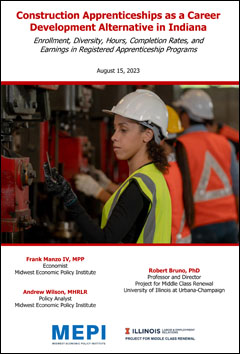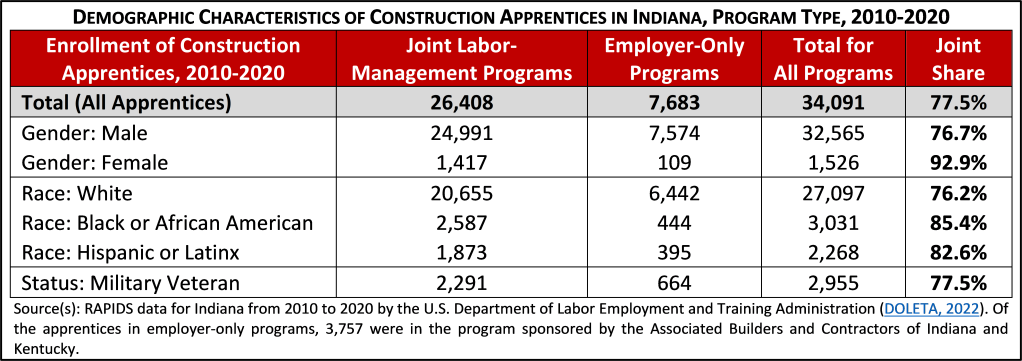NATIONAL
Union apprentices fare better than nonunion trainees, college grads
LA GRANGE, Illinois (Aug. 18, 2023) — Union apprenticeship programs in Indiana’s construction industry deliver more training hours and better diversity outcomes, and result in average earnings for graduates that actually exceed other types of workers with four-year college degrees, according to a new study by the Midwest Economic Policy Institute (MEPI) and the Project for Middle Class Renewal (PMCR) at the University of Illinois at Urbana-Champaign.
 As the construction industry combats a historic labor shortage, the report concludes that union programs are outperforming the nonunion alternative in the production of new construction apprentices.
As the construction industry combats a historic labor shortage, the report concludes that union programs are outperforming the nonunion alternative in the production of new construction apprentices.
To assess the state of construction workforce training in Indiana, MEPI and PMCR researchers utilized 2010-2020 data from the U.S. Department of Labor’s Registered Apprenticeship Partners Information Management Data System (RAPIDS). The researchers also used Current Population Survey data from the U.S. Bureau of Labor Statistics to contrast the performance of union and nonunion apprenticeship programs in Indiana’s construction industry with graduates of two- and four-year college degree programs.
“At a time when the labor market is prioritizing job quality and the construction industry is facing historic demand for new skilled workers to modernize American infrastructure, energy systems, and advanced manufacturing capabilities, this study provides an important analysis of the performance of Indiana’s workforce development institutions,” said MEPI Economist and study coauthor Frank Manzo IV, MPP. “On everything from enrollment and diversity to wages and debt, the data shows that the joint apprenticeship system administered by construction contractors and trade unions is considerably outperforming the alternatives.”

Though just 24% of Indiana’s construction industry has been unionized since 2010, the study shows that training programs jointly administered by unions and signatory contractors enroll 77% of the state’s construction apprentices and boast completion rates that are significantly higher than employer-only (nonunion) programs.
It notes that union apprenticeships not only deliver superior quantities and diversity of construction trade workers, but they also require substantially more training hours than students at universities and community colleges in Indiana, have higher Black and Hispanic enrollment shares than these other post-secondary programs, leave participants entirely free of student debt, and produce average exit wages that exceed those for workers with two- or four-year college degrees in the state.
In explaining the wide disparities in enrollment between union and nonunion programs, researchers highlighted the fact that joint (union) programs include a self-financing instrument—usually cents per hour worked by a union-represented trade worker—that does not exist in the nonunion side of the industry.
“The biggest distinction between union and nonunion construction career training programs is the financing mechanism,” added MEPI Policy Analyst Andrew Wilson, MHRLR. “This ultimately positions joint programs serving the signatory side of the industry to better meet workforce needs in a time of high demand. In the non-signatory side of the industry, investment in long-term workforce training institutions are voluntary and often jettisoned to lower labor costs and win the next bid.”

Noting that these distinctions can invite real consequences for the industry, researchers pointed to a 2022 analysis of Associated General Contractors of America Survey data, which found that nonunion contractors were 16% more likely to report workforce supply problems, 21% more likely to experience project delays due to shortages of workers, and 13% more likely to be losing their workers to other industries entirely.
Additional research has added important context to these issues by documenting differences in job quality between the two sides of the industry. Specifically, research concluded that nonunion construction workers not only earn significantly lower wages upon completion of an apprenticeship, but also were much less likely to have access to employer provided health insurance, more likely to rely on food stamps and other government assistance programs, and more likely to encounter safety problems at work.
In Indiana, the data revealed that graduates of union construction programs earn almost double the wages ($31 per hour) of employer-only program graduates ($17 per hour). The Associated Builders and Contractors of Indiana and Kentucky, the largest nonunion program in the state, had an average exit wage of just $14 per hour.
Read more about the study here.
Do you want to “earn while you learn” a family-wage career in the trades? Check out the Construct a Career website from the Washington State Building and Construction Trades Council about how to get started in a union apprenticeship program today!





